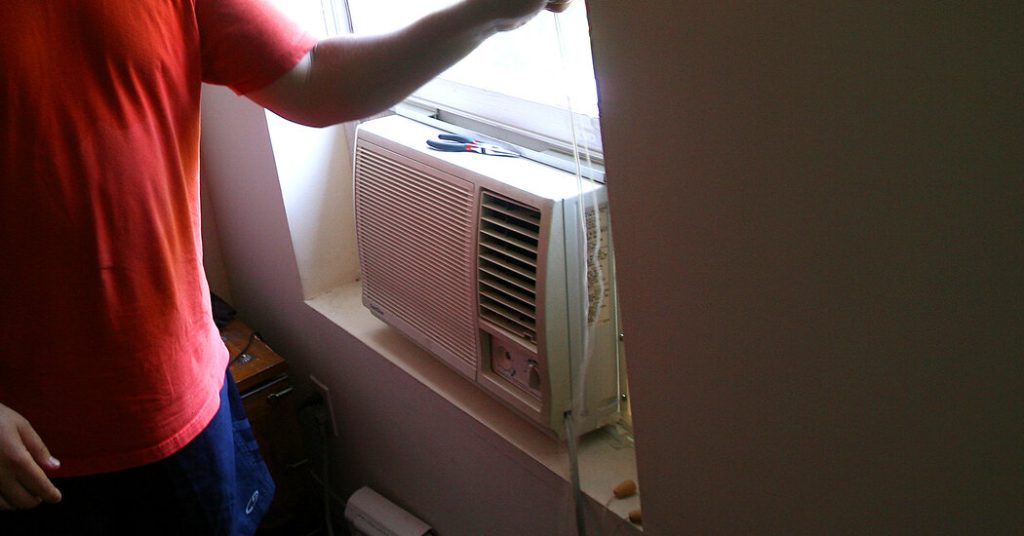Air-conditioners can save lives and keep us comfortable on blistering days. But they may also carry health risks — namely, those related to mold.
This was highlighted again last week, when the manufacturer Midea voluntarily recalled about 1.7 million air-conditioners because of a design flaw that encouraged mold growth.
While that flaw made mold growth more likely, any air-conditioner can get moldy, no matter how well designed it is. Fortunately, there are ways to reduce the risk.
Why do air-conditioners get moldy?
It’s simple: moisture.
Whether you have a window unit or central air, the basic process is the same. Air-conditioners work by repeatedly converting a refrigerant from gas into liquid, and back to gas. As the refrigerant evaporates, it absorbs heat from the air via a cold component called the evaporator coil. A fan blows over the coil, pushing cool air into the home, while hot air is pulled back outside and the refrigerant is condensed back into liquid to restart the process.
As warm air cools, it produces condensation. Think of the way water droplets form on the outside of a glass when you pour cold water into it. In air-conditioners, a drain pan collects this water, and well-designed systems allow it to flow outside rather than remaining stagnant. But those systems can malfunction, or simply be imperfect.
That means moisture may sit inside your air-conditioner for an extended time, leading to mold growth, said Mark Mendell, a former air pollution research specialist at the California Department of Public Health and former staff scientist and epidemiologist at the Lawrence Berkeley National Laboratory.
Dr. Mendell’s research focused on the health effects of mold in indoor air, not on air-conditioners specifically. But the process he described can occur in any kind of air-conditioning system, he said. “There will be water collecting that’s not really draining properly, and maybe it’s dirty. And the air blows over this into your home.”
What are the health risks?
Despite the ubiquity of air-conditioners and their tendency to get moldy, there is not much scientific literature on the health effects.
One of the few such studies, published in 2003, found that when the cooling coils and drain pans inside office air-conditioning systems were irradiated with ultraviolet light to kill bacteria and fungi, workers reported fewer respiratory and other symptoms.
For the most part, though, we must extrapolate from broader research that has examined the health effects of dampness and mold in indoor environments, but not specifically in air-conditioning systems.
A review of that research published in 2011 concluded that exposure to dampness and mold is associated with exacerbations of asthma, coughing, wheezing and upper respiratory symptoms, but it did not establish that mold was the cause. Another review published in 2015 found enough evidence to say that dampness and mold were a reason for exacerbations of asthma in children.
Researchers have found that these types of symptoms are more common in buildings where people can see or smell mold, Dr. Mendell said, but studies haven’t proven connections between symptoms and measurements of specific fungi levels. It’s possible that researchers haven’t measured the right kinds of mold, or that other factors are involved.
“It seems likely that some dampness-related microbiologic exposures will turn out to be the cause of the health problems, but we just don’t know for sure yet,” Dr. Mendell said.
What precautions can you take?
Basic air-conditioner maintenance, such as regularly cleaning filters, can help prevent mold growth. Many window units have a light that indicates when cleaning is needed, but once or twice a month is a good rule of thumb.
Whether you have window units or central air, controlling humidity in your home, with a dehumidifier if necessary, is also helpful. And it’s a good idea to keep your home clean in general, because that will limit the amount of dust, a food source for mold, that can get into the air-conditioner. Running an air purifier can remove both dust and mold spores.
But these precautions aren’t a panacea. You should inspect your air-conditioner periodically, especially if it’s been unused for an extended period, such as over the winter.
Mold may be visible around the vents, and a flashlight can help you look deeper. If you’re up for it, you can also disassemble a window unit according to the instructions in the manual, to more closely inspect and, if necessary, clean the coils and the drain pan.
Detailed cleaning instructions for both window and central air-conditioning units can be found here.


